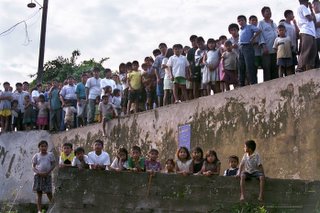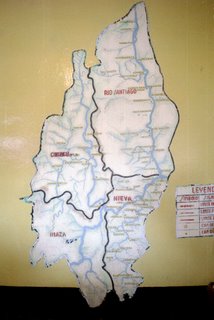

In January of 2002, CNN reported a massacre in the remote jungle region of Northern Peru. Settlers had been attacked by upwards of 150 Aguaruna Indians. The Aguaruna were in war paint, their faces red and black. They used rifles, bows and arrows, machetes, and shotguns and blowguns (loaded with poison tipped darts) to kill 15 settlers, seven of them children. Scores of others were wounded in the attack.
The roots of the problem date back to 1981 when then-president Fernando Belaunde Terry declared the Cajamarca jungle an economic expansion zone, and launched a campaign to “Peruvianize” the Aguaruna. Belaunde did this for security reasons. He wanted to create a demographic barrier to curtail Ecuador’s attempts to penetrate the area. This involved not only making the Aguaruna identify as Peruvians, but also bringing in settlers from other parts of Peru to help populate the sparsely inhabited region. The colonists flocked to the region- engaging in agriculture, especially the growing of coffee.
The Aguaruna have been struggling against this incursion into their lands since its beginning. They are the most politically organized of Peru’s indigenous groups, and until recently their battles were carried out mostly in the courtroom. This tactic saw much success, especially in the late 1990s, with several different courts finding in favor of the Aguaruna and recognizing as valid the property titles the Aguaruna hold for the land.
The colonist settlers did not recognize the claims of the Aguaruna. They stayed on the land, leaving only briefly in 2000, but returning after the case was appealed and moved into a higher court. The Ministry of Agriculture offered the settlers other land, but the settlers were adamant- they would not leave. When they saw that their final appeal had failed, the colonists formed their own paramilitary force, comprised of peasants and known as the “ronderos.” Several of the settlers armed themselves with rifles, preparing to defend against forcible eviction. The police are not allowed to use their weapons in such situations, so the settlers remained.
On January 12 2002, the eviction was again supposed to take place. The settlers, demonstrating no small amount of media savvy, invited a local television station to witness the proceedings. The Peruvian government, unwilling to risk a public relations disaster, backed down.
Seeing the government as unwilling, or unable to rid their land of the trespassers, the Aguaruna decided that they had to act, and on January 19, they did.
How Sad!
ReplyDelete:"(
Why is it sad?
ReplyDelete